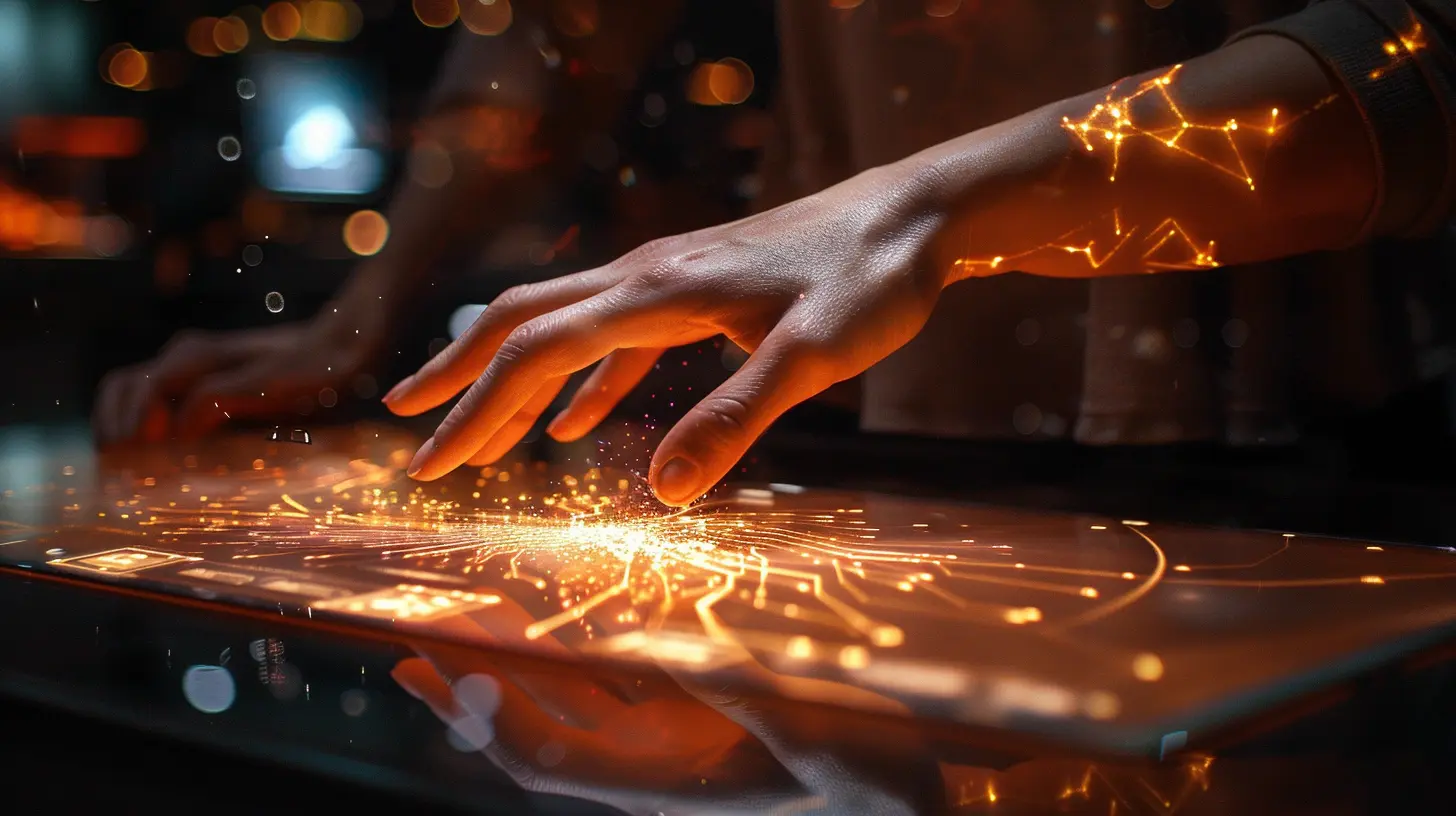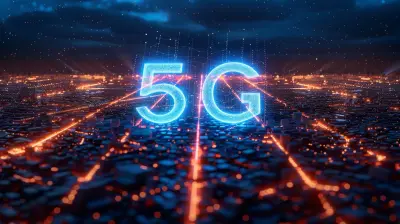Holographic Displays: The Next Big Leap in Screen Technology
21 October 2025
Hey there, fellow tech enthusiasts! 🌟
Ever watched a sci-fi flick and thought, “Wow, I wish I had one of those floating 3D screens at home”? You’re not alone. The dream of holographic displays is no longer just for Jedi councils or Tony Stark’s lab—it’s becoming a real thing. And guess what? We’re inching closer to experiencing it in our everyday lives!
So, grab your favorite drink, sit back, and let’s dive into the dazzling world of holographic displays—where screens jump out at you, quite literally.
🧠 What Are Holographic Displays Anyway?
Let’s clear the fog first. Holographic displays are systems that create three-dimensional images that float in space—no glasses, no VR headsets, just visuals you can walk around (okay, maybe not yet, but almost!).Unlike traditional screens that show a flat image, think of holographic displays as magic boxes projecting depth and light into thin air. The result? An image you can view from multiple angles—just like real life. Mind = Blown 🤯
🎬 From Sci-Fi to Reality: The Journey So Far
It used to be science fiction—heck, Tupac even made a posthumous concert appearance as a hologram in 2012! That raised eyebrows and set imaginations on fire.But science fiction is slowly morphing into science fact. With major tech giants investing heavily in this field (yep, we’re talking about Microsoft, Samsung, and Google), the holographic future is no longer a pipe dream.
New breakthroughs are happening in:
- Light field technology
- Laser plasma emission
- Augmented reality
- Volumetric displays
These buzzwords may sound fancy, but trust me, they just mean we’re getting closer to seamlessly projecting 3D visuals into real spaces… with no special glasses or gear.
💡 Why Holographic Displays Matter
Okay, so holograms are cool. But you might ask, “Why should I care?” Oh, let me count the ways:1. True 3D Experience
Flat screens be gone! Unlike 3D TVs that needed glasses (ugh, remember those?), holographic displays give you a real sense of depth. It’s like looking at a miniature theater playing out right in front of you.2. No Gear, No Problem
One of the biggest issues with AR and VR today? The hardware. Clunky headsets and goggles are a pain. Holographic displays eliminate that barrier. No glasses = more comfort + accessibility.3. Next-Level Communication
Imagine FaceTiming your friend and seeing them pop up as a hologram right in your living room. It’s personal, it’s immersive, and yeah—it’s downright cool.4. Revolutionizing Industries
- Education: Visualizing complex subjects in 3D (think biology or geography!)- Healthcare: Medical training with life-like human anatomy projections
- Engineering: 3D prototyping without physical models
- Entertainment: Holograms in concerts, movies, even games
Seriously, the possibilities are endless.
🔬 The Tech Behind the Magic
Let’s nerd out a bit, shall we?Holographic displays typically rely on some key technologies:
🔹 Light Field Displays
These simulate the natural behavior of light rays, allowing eyes to focus and adjust naturally to different depths—just like the real world.🔹 Laser Plasma Technology
Sounds like Star Wars tech, right? It’s actually lasers creating tiny plasma bursts in the air to form 3D points of light. Combined, these form those floating images. Wild stuff!🔹 Spatial Light Modulators (SLMs)
Think of these as the brain behind the display. They control how light is bent and shaped to build 3D visuals.So yeah, the technology is crazy complex, but the idea is simple—bring images to life.
🚀 Who’s Leading the Charge?
Let’s give a shout-out to the brave pioneers of this mesmerizing tech:💼 Microsoft
With its HoloLens platform, Microsoft has been at the forefront of merging augmented reality and holography. While it needs a headset for now, the groundwork is being laid for gear-free displays too.📱 Looking Glass Factory
These guys are killing it. Their Looking Glass Portrait is a desktop holographic display you can actually buy. 3D memories at your fingertips? Yes, please.🧠 Light Field Lab
This startup is building massive holographic panels that don’t need glasses and create ultra-realistic floating visuals. Their goal? A full-blown holodeck. Count us in.🔍 Samsung, Google, Apple
All the big boys are quietly (or not so quietly) investing in holographic tech. Patents, R&D labs, test devices—you name it. When these giants jump in, you know it’s serious.🧨 Challenges Still in the Way
Of course, it’s not all sunshine and 3D rainbows. We’re still facing a few bumps on the road:- Cost: Holographic displays aren't cheap... yet.
- Processing Power: Rendering real-time 3D visuals = serious computing muscle.
- Content Creation: Need new tools and formats to build usable 3D content.
- Display Size: Most holograms are still pretty small. We're not quite at movie-screen level.
But hold tight—tech evolves fast. Remember when flat-screen TVs were once ultra-expensive and now you can grab a 50-inch one for peanuts? Yep, we’re heading that way.
🌈 Real-World Applications You’ll Actually Use
Let’s paint a picture 🖼️ of how holographic displays will sneak into your daily life sooner than you think:👨⚕️ Healthcare
Surgeons using 3D models of organs to plan procedures. Patients understanding their conditions better through visualizations. Holograms could literally save lives.💼 Business & Remote Work
Think virtual meetings with floating charts, blueprints, and even life-size versions of team members. Zoom fatigue? Gone.🎮 Gaming
You thought VR was cool? Imagine being IN the game—without wearing anything. Your living room becomes the battlefield. Fortnite, anyone?🛍️ Retail & E-commerce
Try-before-you-buy holograms. Picture yourself virtually wearing those sneakers or seeing how that couch looks in your room… in 3D.🏫 Education
Field trips to Mars. Anatomy classes with floating organs. History lessons with holographic reenactments. When learning becomes this fun, who wouldn’t pay attention?📱 Holographic Smartphones – Are They Coming?
Short answer—yes. In fact, they’ve already been teased. Remember the RED Hydrogen One? It had a holographic display but flopped due to poor implementation.But don’t count it out. As components shrink and software leaps ahead, we’re likely just a version or two away from smartphones that project content in mid-air.
Imagine checking your messages or scrolling Instagram in free space in front of your eyes. That’s not just “futuristic”—it’s inevitable.
🧐 Are Holographic Displays the Future of All Screens?
Okay, let’s keep it real. Will every screen become holographic?Probably not. There will always be a place for traditional screens—they’re cheap, efficient, and work perfectly for lots of tasks.
But for stuff like immersive communication, design, education, and entertainment—holography offers a literal new dimension. It won’t replace all screens, but it will revolutionize how we see and interact with visual data.
Think of it like this: VHS ➡️ DVD ➡️ Blu-ray ➡️ Streaming ➡️ Holograms. Each step offers more immersion.
🔮 What’s Next?
The future is closer than you think. As AI, edge computing, and optical technologies advance, we’re going to see:- Bigger and better holographic displays
- Consumer-level devices becoming affordable
- New creative tools for 3D storytelling
- Integration with AR and IoT
So don’t be surprised if one day you walk into a store, and a holographic assistant pops up to greet you. Or your next Zoom call turns into a table-wide 3D meeting. The future’s not far—it’s basically knocking on your door.
And when that day comes? You’ll remember this article and nod knowingly. 😉
🎉 Final Thoughts
Holographic displays are more than just eye candy—they represent a paradigm shift in how we experience digital information. From education to entertainment, from healthcare to design, this tech is poised to change the way we see the world—literally.It’s a tech dream turning into a tangible reality. And honestly? I can’t wait to see what’s next. Buckle up, folks. The holographic future is glowing bright, and it’s gonna be an absolute blast!
all images in this post were generated using AI tools
Category:
Tech InnovationsAuthor:

Adeline Taylor
Discussion
rate this article
1 comments
Serenity Lawson
Exciting advancements! Looking forward to seeing this technology evolve.
October 30, 2025 at 3:45 AM

Adeline Taylor
Thank you! We're equally excited to see where holographic displays will take us. Stay tuned!


